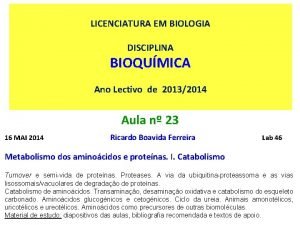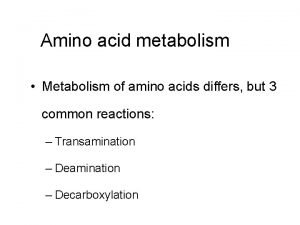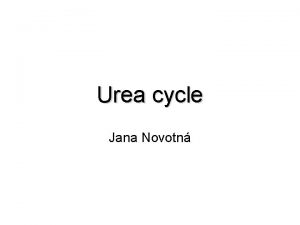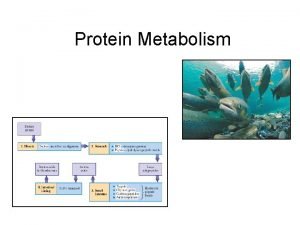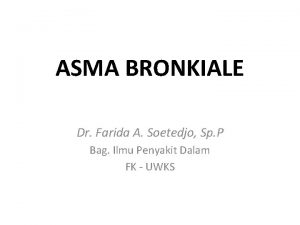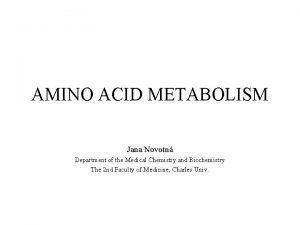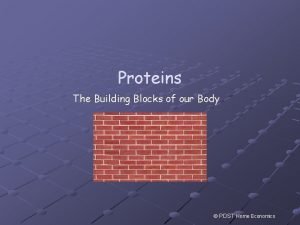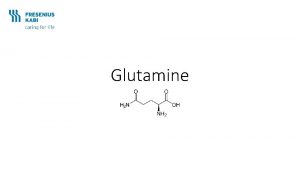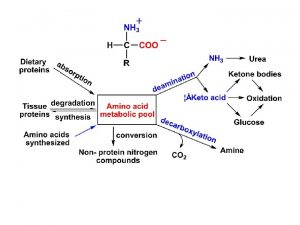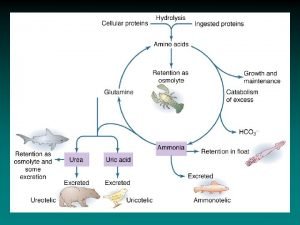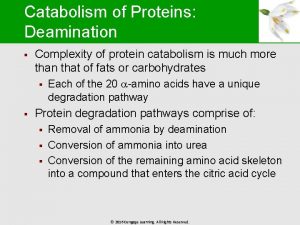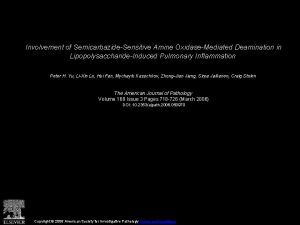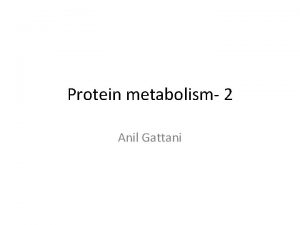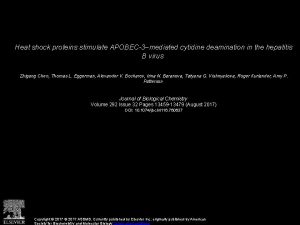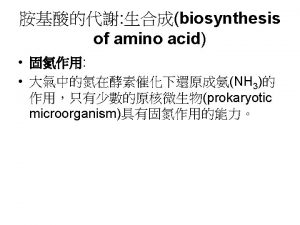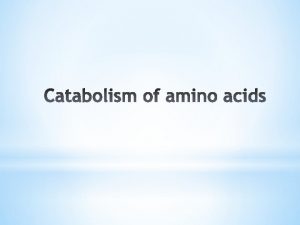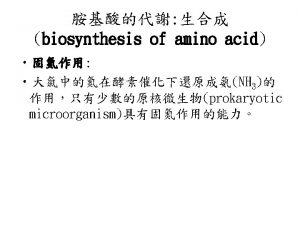Transamination Deamination MISS FARIDA ZAI Transamination Transamination a

















- Slides: 17

Transamination & Deamination: MISS FARIDA ZAI

Transamination: Transamination, a chemical reaction that transfers an amino group to a ketoacid to form new amino acids. This pathway is responsible for the deamination of most amino acids. This is one of the major degradation pathways which convert essential amino acids to non-essential amino acids.

Enzymes utilized: Transamination in biochemistry is accomplished by enzymes called transaminases or aminotransferases. α-ketoglutarate acts as the predominant amino-group acceptor and produces glutamate as the new amino acid. Aminoacid + α-ketoglutarate ↔ α-keto acid + Glutamate's amino group, in turn, is transferred to oxaloacetate in a second transamination reaction yielding aspartate. Glutamate + oxaloacetate ↔ α-ketoglutarate + aspartate

Mechanism: Transamination catalyzed by aminotransferase occurs in two stages. In the first step, the α amino group of an amino acid is transferred to the enzyme, producing the corresponding α-keto acid and the aminated enzyme. During the second stage, the amino group is transferred to the keto acid acceptor, forming the amino acid product while regenerating the enzyme. The chirality of an amino acid is determined during transamination

Continuation: For the reaction to complete, aminotransferases require participation of aldehyde containing coenzyme, pyridoxal-5'-phosphate (PLP), a derivative of Pyridoxine (Vitamin B 6). The amino group is accommodated by conversion of this coenzyme to pyridoxamine-5'-phosphate (PMP). PLP is covalently attached to the enzyme via a Schiff Base linkage formed by the condensation of its aldehyde group with the ε-amino group of an enzymatic Lys residue. The Schiff base, which is conjugated to the enzymes pyridinium ring is the focus of the coenzyme activity.

Continuation: The product of transamination reactions depend on the availability of α-keto acids. The products usually are either alanine, aspartate or glutamate, since their corresponding alpha-keto acids are produced through metabolism of fuels. Being a major degradative aminoacid pathway, lysine, proline and threonine are the only three amino acids that do not always undergo transamination and rather use respective dehydrogenase. Alternative Mechanism. A second type of transamination reaction can be described as a nucleophilic substitution of one amine or amide anion on an amine or ammonium salt. [1] For example, the attack of a primary amine by a primary amide anion can be used to prepare secondary amines: RNH 2 + R'NH− → RR'NH + NH 2−Symmetric secondary amines can be prepared using Raney nickel (2 RNH 2 → R 2 NH + NH 3). And finally, quaternary ammonium salts can be dealkylated using ethanolamine: R 4 N+ + NH 2 CH 2 OH → R 3 N + RN+H 2 CH 2 OHAminonaphthalenes also undergo transaminations.


Deamination: Deamination is the removal of an amino group from a molecule. Enzymes that catalyse this reaction are called deaminases. In the human body, deamination takes place primarily in the liver, however can also occur in the kidney.

Location: In the human body, deamination takes place primarily in the liver, however can also occur in the kidney.

Purpose : In situations of excess protein intake, deamination is used to break down amino acids for energy. The amine group is removed from the amino acid and converted to ammonia. The rest of the amino acid is made up of mostly carbon and hydrogen, and is recycled or oxidized for energy. Ammonia is toxic to the human system, and enzymes convert it to urea or uric acid by addition of carbon dioxide molecules (which is not considered a deamination process) in the urea cycle, which also takes place in the liver. Urea and uric acid can safely diffuse into the blood and then be excreted in urine.

Mechanism: Spontaneous deamination is the hydrolysis reaction of cytosine into uracil, releasing ammonia in the process. This can occur in vitro through the use of bisulfite, which deaminates cytosine, but not 5 -methylcytosine. This property has allowed researchers to sequence methylated DNA to distinguish nonmethylated cytosine (shown up as uracil) and methylated cytosine (unaltered).

Mechanism: In DNA, this spontaneous deamination is corrected for by the removal of uracil (product of cytosine deamination and not part of DNA) by uracil-DNA glycosylase, generating an abasic (AP) site. The resulting abasic site is then recognised by enzymes (AP endonucleases) that break a phosphodiester bond in the DNA, permitting the repair of the resulting lesion by replacement with another cytosine. A DNA polymerase may perform this replacement via nick translation, a terminal excision reaction by its 5'� 3' exonuclease activity, followed by a fill-in reaction by its polymerase activity. DNA ligase then forms a phosphodiester bond to seal the resulting nicked duplex product, which now includes a new, correct cytosine (Base excision repair

5 methyl cytosine: Spontaneous deamination of 5 -methylcytosine results in thymine and ammonia. This is the most common single nucleotide mutation. In DNA, this reaction, if detected prior to passage of the replication fork, can be corrected by the enzyme thymine-DNA glycosylase, which removes the thymine base in a G/T mismatch. This leaves an abasic site that is repaired by AP endonucleases and polymerase, as with uracil-DNA glycosylase.

Guanine: Deamination of guanine results in the formation of xanthine. Xanthine, in a manner analogous to the enol tautomer of guanine, however, it still pairs with cytosine.

Adenine: Deamination of adenine results in the formation of hypoxanthine. Hypoxanthine, in a manner analogous to the imine tautomer of adenine, selectively base pairs with cytosine instead of thymine. This results in a post-replicative transition mutation, where the original A-T base pair transforms into a G-C base pair.


 Urocanate reductase
Urocanate reductase Oxidative deamination of amino acids
Oxidative deamination of amino acids Urea amino acids
Urea amino acids Transamination and oxidative deamination
Transamination and oxidative deamination Transamination vs deamination
Transamination vs deamination Farida fassi
Farida fassi Dress like an egyptian
Dress like an egyptian Farida fassi
Farida fassi Asma farida
Asma farida Iphone swot
Iphone swot Ta jia zai nar meaning in english
Ta jia zai nar meaning in english Short story cat and mouse 1
Short story cat and mouse 1 Ohayo gozaimas
Ohayo gozaimas Jia lasson
Jia lasson Rang dong restaurant
Rang dong restaurant Jana novotn
Jana novotn Bv of protein
Bv of protein Deamination of glutamine
Deamination of glutamine
